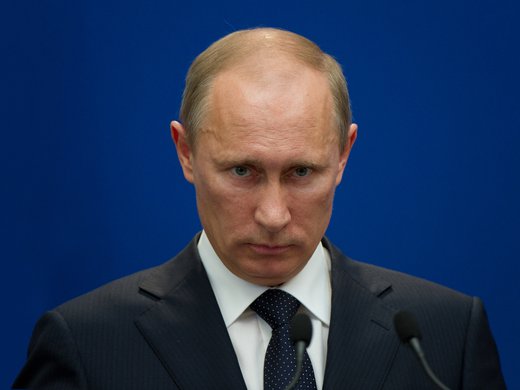Amid a great deal of controversy and some visceral reactions from Europe, US President Donald Trump recently signed the Countering America’s Adversaries Through Sanctions Act, which levies new economic sanctions on the Islamic Republic of Iran, the Russian Federation and the Democratic People’s Republic of Korea.
The sanctions bill is wide-reaching, and attempts to punish all three countries on a host of issues.
It sanctions Iranian individuals and organizations for Tehran’s ballistic missile activities and the Iranian Revolutionary Guard Corps’ alleged support of international terrorism; targets Russia for its government’s alleged use of cyber attacks on foreign governments and its military presence in Ukraine; and seeks to strengthen existing United Nations sanctions on North Korea.
It is important to note that the United States routinely uses economic sanctions — and the threat thereof — as a tool to deter foreign governments from adopting certain policies, to punish them if they do things that Washington believes harms American interests, and to force foreign governments to the negotiating table. New sanctions are not in and of themselves particularly significant.
However, this time is different, particularly when it comes to relations between the United States, Western Europe and Russia. Here is why.
The bill takes back the foreign policy powers of Congress from the president.
Section 216 of the new bill prevents the US president from unilaterally lifting or modifying sanctions against Russian nationals or organizations. Instead, it requires the White House to justify any proposal to lift or suspend sanctions to Congress, which would then approve or deny any such request. While the president can still veto Congress’s rejection of his efforts to lift the sanctions — so long as Congress does not reject the sanctions’ suspension with a two-thirds supermajority — the bill sets a major legislative hurdle for any president that wants to offer Russia sanctions relief.
President Trump was effectively forced to sign this check on his powers under protest given the lopsided votes in favour of the bill on Capitol Hill, where it received overwhelming bipartisan support in both the House of Representatives (where it passed 419–3) and the Senate (with a vote of 98–2). If the bill had been vetoed in the Oval Office, it is likely Congress would have overruled the veto with a two-thirds supermajority vote.
Typically, American presidents can unilaterally suspend sanctions, giving them a potentially powerful negotiating tool when dealing with foreign governments. The promise of economic relief can be a powerful incentive to get an adversary to the negotiating table: proponents of the 2015 Joint Comprehensive Plan of Action that froze some of Iran’s nuclear activities argue that it was US-led financial sanctions, which cut off Iran from global oil markets and devastated its currency, that ultimately brought Tehran to the negotiating table.
The sanctions bill therefore appears to be a serious rebuke of President Trump’s Russia policy, and a significant reassertion of some of Congress’s constitutionally enshrined foreign policy powers. For those who work or interact with the US government, Congress’s bold move to challenge the president’s Russia policy should serve as a call to begin paying very close attention to the entirety of the American foreign policy community, rather than just the executive branch and State Department. If section 216 signals that Congress is ready to take a substantive role in US foreign policy making for the next 40 months, then foreign governments are going to have to consider looking at ways to coordinate policy with Washington’s legislature.
The bill intensifies a hard-line policy on Russia and Ukraine.
Many of the unilateral US efforts to convince Moscow to withdraw from the Crimean Peninsula and to cease support for the Donetsk and Luhansk People’s Republics have come in the form of economic sanctions that deny specific Russian firms and Ukrainian and Russian individuals access to the US financial system and that freeze their US-based assets. The new sanctions legislation expands and codifies those sanctions in at least two significant ways.
The first is that the bill enshrines a number of Russia and Ukraine sanctions into law. Until now, the legal basis of many of these sanctions have been executive orders issued by President Barack Obama. While executive orders have the force of law in the United States, they are simple to rescind: the president may simply revoke an order, including those orders issued by a predecessor. Section 222 codifies six of President Obama’s executive orders levying sanctions against Russian and Ukrainian entities and individuals into law.
A second notable way that the bill hardens US policy against Russia is the way it treats the Russian oil sector. Under Executive Order 13662, Americans and people based in the United States were prohibited from conducting a broad range of business activities with a long list of Russian energy firms, including OAO Gazprom and many of its subsidiaries. The sanctions bill extends that list by also prohibiting participating in any oil exploration or production projects in which a prohibited Russian firm has a 33 percent (or greater) ownership stake. This forces US firms (and those operating in the United States) to be particularly wary of conducting any business in not just Russia’s oil sector, but anywhere in the world Russian firms may be involved. Whereas the Department of the Treasury could draw up a negative list of prohibited energy firms (as directed in Executive Order 13662), Congress’s 33 percent ownership rule could require US firms to tread very carefully when looking at joint venture projects around the world.
These two modifications to the Russia sanctions alone send a strong signal to Moscow: the United States is willing to keep current sanctions on the books for a long time, and is willing to further curb the ability of American firms to do business in the global oil sector. While the restrictions on joint ventures in the final bill are not as severe as in some earlier drafts, they still send the message that the United States is willing to tolerate some economic pain in order to punish Russia for its invasion of Ukraine. Combined with the restrictions that the bill puts on the president’s ability to unilaterally deal with the Russian government, the message to the Kremlin should be clear: relations will not normalize until Russia withdraws from Ukraine.
On balance, this should strengthen multilateral efforts to manage the conflict in eastern Ukraine and efforts to resolve the broader political struggle over the fate of post-Soviet Eastern Europe. The decision by Congress to keep holding the Kremlin accountable for invading Crimea and the war in the Donbass region is a strong signal to Canada and Western Europe that there is broad support in the United States for a resolute, long-term effort to stop Europe from backsliding into spheres of influence.
The message from Congress is clear: however valid Russian concerns in the wake of the 2014 ouster of Ukrainian President Viktor Yanukovych may be, Moscow’s policy of preventing Ukraine from moving closer to the European Union by occupying it is unacceptable.
Acquiescing to the occupation of Ukraine, in Washington’s view, risks damaging the entire European security order, which relies on countries freely entering into alliances and foreign relationships on their own terms.
The new bill could entangle the United States in European politics.
The fine print of the bill also empowers the president to sanction individuals or firms that do business with the Russian Federation on any energy export pipelines. The bill’s language on this issue is purposefully broad, and can be interpreted as allowing the president to sanction any firm or individual — regardless of jurisdiction — who participates in a Russian government–backed pipeline project.
One of the most obvious targets of this provision is Gazprom’s Nord Stream 2 project.[1] If completed, Nord Stream 2 could transport as much as 55 billion cubic metres of natural gas per year along the bottom of the Baltic Sea from Russia to the German town of Greifswald. It is a politically divisive project in Europe. Critics argue that it would not increase the supply of natural gas from Russia to central Europe, but instead carry natural gas that was already destined for the European market and would otherwise have been transported through Ukraine. Accordingly, critics argue that since the pipeline has been designed to bypass Ukraine, Nord Stream 2 should be seen as a Russian foreign policy tool that binds the European Union and Russia in a long-term commercial relationship while simultaneously economically (and politically) isolating Kiev. Accordingly, over a dozen EU governments have expressed opposition to the project, and argue that the European Commission, the executive branch of the European Union, ought to be able to deal with Russia directly about the project on behalf of all 28 EU members.
According to the German government, though, the project is a bilateral matter between Berlin and Moscow. This disagreement pits German commercial interests against the strategic interests of the European Union’s eastern and central European members, and the new bill is a loud declaration by the American Congress that they are siding with Eastern Europe.
The reaction from Germany has been swift and strongly worded. Brigitte Zypries, Germany’s economics minister, said, “We consider this as being against international law, plain and simple,” and the German Committee on Eastern European Economic Relations, a trade group that represents German firms that do business in Eastern Europe, suggested that counter-sanctions against the United States might be warranted.
That the White House will sanction firms working on Nord Stream 2 is not a foregone conclusion. The bill calls for sanctions on participants in pipeline projects only “in coordination with allies of the United States,” which suggests that Congress is not calling for unilateral US action. Berlin’s concerns that the bill will be used to harm German firms may be overblown, at least for the time being. Nevertheless, the combination of the bill’s assertion that the United States has the right to sanction firms working on Russian pipelines, and section 257’s statement that the United States is — as a matter of policy — opposed to Nord Stream 2, sends a clear message to the German government.
This may not be the last chapter in the policy rift between the president and Congress.
After months of speculation that the Republican Party and President Trump would inevitably come into conflict about substantive policy issues, we are witnessing the arrival of such a moment. Not only did the Countering America’s Adversaries Through Sanctions Act pass both houses with overwhelming bipartisan support, the bill obviously enjoyed the support of Republican leadership in both chambers. Despite protests from both the White House and State Department about section 216, President Trump swiftly signed the bill into law.
While the decision of Congress to continue to hold the Russian government to account for its invasion and destabilization of Ukraine will likely have a stabilizing effect on transatlantic relations, in that it will reassure America’s military and trade partners in Europe that the United States is not acquiescing to Russia’s efforts to dominate the foreign policies of its Eastern European neighbours, opponents of President Trump’s foreign policy should not be too heartened by the bill.
While it is too early to conclude that the sanctions legislation marks a complete breach between congressional Republicans and the White House, it is the clearest evidence yet that the two branches of government are not of one mind on Russia. Furthermore, the debate over the bill signals that those differences are not simply about how best to achieve America’s Russia policy goals, but about what those goals should be. Congress simply may not trust the president to act in the nation’s interests when dealing with Moscow. This disagreement about Russia policy could set the stage for future congressional-executive disagreements, and send mixed signals to the rest of the world about the direction, tone and content of US foreign policy, causing considerable uncertainty.



